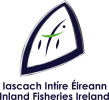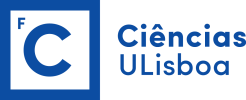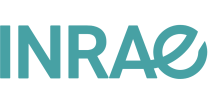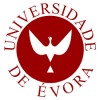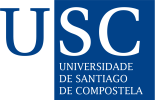Welcome to DiadSea Project
Transnational cooperation to improve the management and conservation of diadromous fish at sea
About the Project
DiadSea project is a transnational cooperation initiative of 9 beneficiary partners and 28 associated partners from 4 European countries (Portugal, France, Spain, and Ireland), led by the University of Évora/MARE, that is aimed at improving the management and conservation of diadromous migratory fish at sea in the Atlantic Area. Diadromous fish live in both fresh and saltwater, which makes it challenging to manage and protect them. They are found in the Atlantic Area, but there aren’t many shared solutions to deal with the problems they face, especially with the added issues of climate change. By protecting these fish and their habitats, DiadSea will not only help the environment but also bring benefits to local communities, both economically and culturally.
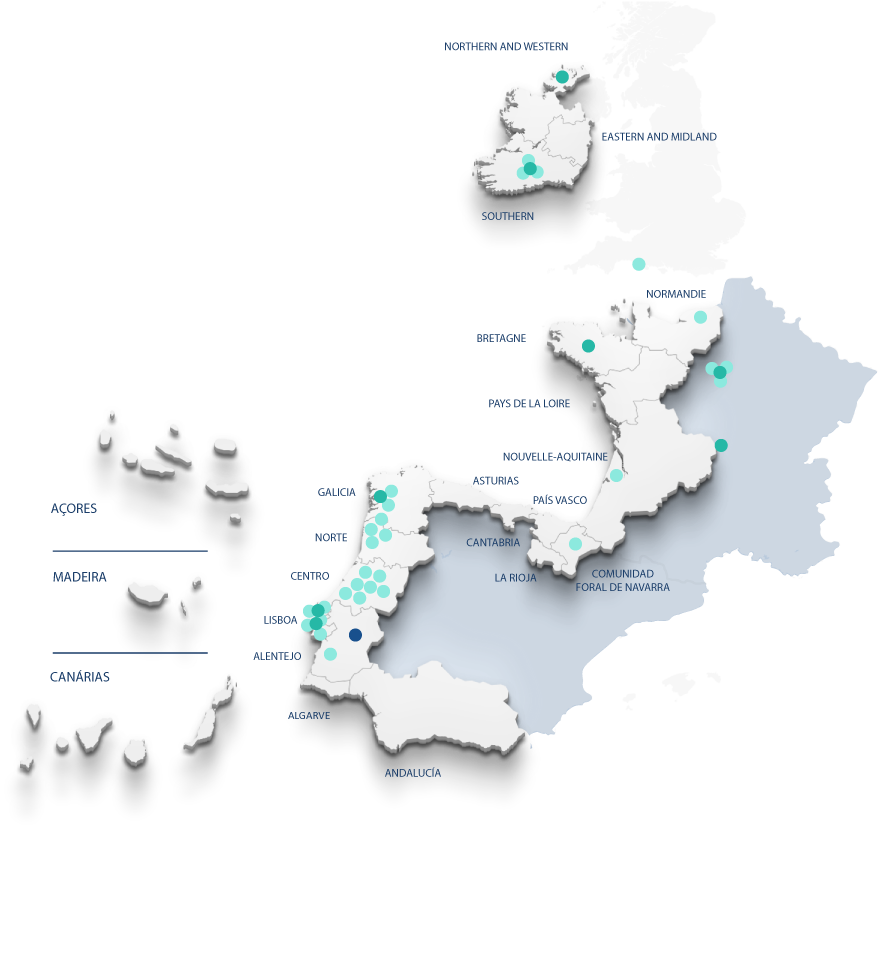
Lead partner (dark blue), beneficiary partners (dark green) e associated partners (light green)
Our Work Packages
-
1
Biological data collection
WP1 will focus on collecting biological data during the marine phase of diadromous fish (DF) life cycles to fulfil the lack of knowledge that exists during this phase. Data collected will be used in the development of new tools to predict the effect of climate change on DF marine distributions in terms of habitat suitability and connectivity at a large scale. The WP includes four activities:
-
2
Innovative methods to fill gaps in data-poor species
WP2 will assess novel methodological approaches targeting data-poor diadromous fish to obtain information on the marine life stage of their life cycles. The WP includes five activities:
-
3
Assessment of priority areas for conservation
WP3 will develop new tools to predict the effect of climate change on diadromous fish (DF) marine distributions in terms of habitat suitability and connectivity at a large scale and for all the species targeted by the project. The aim is to identify the suitability of marine habitats and the evolution of this suitability in the context of climate change using several climate change scenarios. The final aim is the identification of priority areas for action to improve the management of these species. Its main output is an improved and updated Interactive Web Atlas.
-
4
Transnational management of diadromous fishes
WP4 will develop innovative cooperative solutions to protect biodiversity and the natural resources of diadromous fish(DF) in marine habitat and, subsequently, in freshwater habitat. Its main outputs are: O9 - Implementation of a transnational Observatory; O10 - Policy guidelines for DF management. The WP includes four activities:
-
5
Tools for capacitation and capitalization DF towards sustainability
WP5 aims to deliver sustainable long-term benefits for the management and conservation of diadromous fish (DF) species through a capitalization strategy involving all partners and stakeholders. Its main outputs are: O11 – the creation of an integrated label of origin system; O12 – a card game and comic book around diadromous species. The WP includes three activities:
-
Biological data collection
WP1 will focus on collecting biological data during the marine phase of diadromous fish (DF) life cycles to fulfil the lack of knowledge that exists during this phase. Data collected will be used in the development of new tools to predict the effect of climate change on DF marine distributions in terms of habitat suitability and connectivity at a large scale. The WP includes four activities:
-
1. Compilation of historical fisheries-dependent and independent data on DF marine phase (leader: IFI)
Compilation of historical fisheries-dependent and independent data on DF marine phase (leader: IFI)
-
2. Assessment of data gaps and definition of required solutions (leader: IFI)
Assessment of data gaps and definition of required solutions (leader: IFI)
-
3. Filling data gaps on the DF marine and estuarine phase (leader: IFI)
Filling data gaps on the DF marine and estuarine phase (leader: IFI)
-
4. Networking activities and procedures for stakeholder’s support engagement (leader: UÉvora)
Networking activities and procedures for stakeholder’s support engagement (leader: UÉvora)
-
-
Innovative methods to fill gaps in data-poor species
WP2 will assess novel methodological approaches targeting data-poor diadromous fish to obtain information on the marine life stage of their life cycles. The WP includes five activities:
-
1. Unravelling Sea lamprey ecology at sea with DNA metabarcoding and tagging (leader: FCUL)
Unravelling Sea lamprey ecology at sea with DNA metabarcoding and tagging (leader: FCUL)
-
2. Mapping shad coastal habitat suitability in the NW Iberian Peninsula with innovative environmental variables (leader: IPMA)
Mapping shad coastal habitat suitability in the NW Iberian Peninsula with innovative environmental variables (leader: IPMA)
-
3. Progressing on marine migration of European eel larvae, maternal origin of spawners and the panmixia hypothesis (leader: MNHN); 2.4 - Dynamic Salmonid Ocean Climate Modelling (leader: MI); A2.5 - Networking activities and stakeholder’s support engagement (leader: UÉvora).
Progressing on marine migration of European eel larvae, maternal origin of spawners and the panmixia hypothesis (leader: MNHN); 2.4 - Dynamic Salmonid Ocean Climate Modelling (leader: MI); A2.5 - Networking activities and stakeholder’s support engagement (leader: UÉvora).
-
4. Dynamic Salmonid Ocean Climate Modelling (leader: MI)
Dynamic Salmonid Ocean Climate Modelling (leader: MI)
-
5. Networking activities and stakeholder’s support engagement (leader: UÉvora)
Networking activities and stakeholder’s support engagement (leader: UÉvora)
-
-
Assessment of priority areas for conservation
WP3 will develop new tools to predict the effect of climate change on diadromous fish (DF) marine distributions in terms of habitat suitability and connectivity at a large scale and for all the species targeted by the project. The aim is to identify the suitability of marine habitats and the evolution of this suitability in the context of climate change using several climate change scenarios. The final aim is the identification of priority areas for action to improve the management of these species. Its main output is an improved and updated Interactive Web Atlas.
-
1. Diadromous species marine distribution models for baseline and future climate change scenarios .
Diadromous species marine distribution models for baseline and future climate change scenarios .
-
2. Identification of areas with higher turnover for diadromous species in marine areas under climate change scenarios.
Identification of areas with higher turnover for diadromous species in marine areas under climate change scenarios.
-
3. Vulnerability and opportunities assessment for the species of interest, particularly the ones considered as data poor under climate change scenarios .
Vulnerability and opportunities assessment for the species of interest, particularly the ones considered as data poor under climate change scenarios .
-
4. Identification of important areas to ensure longitudinal (sea-river interface) and latitudinal connectivity through time .
Identification of important areas to ensure longitudinal (sea-river interface) and latitudinal connectivity through time .
-
5. Improving the Interactive Web Atlas with current and future distributions of diadromous species at sea.
Improving the Interactive Web Atlas with current and future distributions of diadromous species at sea.
-
-
Transnational management of diadromous fishes
WP4 will develop innovative cooperative solutions to protect biodiversity and the natural resources of diadromous fish(DF) in marine habitat and, subsequently, in freshwater habitat. Its main outputs are: O9 - Implementation of a transnational Observatory; O10 - Policy guidelines for DF management. The WP includes four activities:
-
1. Characterization of the present management status in each AA region.
Characterization of the present management status in each AA region.
-
2. Creation of an Observatory composed of stakeholders in DF management and conservation.
Creation of an Observatory composed of stakeholders in DF management and conservation.
-
3. Development of an adaptive fisheries management plan for DFA
Development of an adaptive fisheries management plan for DFA
-
4. Creation of innovative policy guidelines to strengthen DF management in the AA.
Creation of innovative policy guidelines to strengthen DF management in the AA.
-
-
Tools for capacitation and capitalization DF towards sustainability
WP5 aims to deliver sustainable long-term benefits for the management and conservation of diadromous fish (DF) species through a capitalization strategy involving all partners and stakeholders. Its main outputs are: O11 – the creation of an integrated label of origin system; O12 – a card game and comic book around diadromous species. The WP includes three activities:
-
1. Creation of a transnational and integrated label of origin system (leader UÉvora);
Creation of a transnational and integrated label of origin system (leader UÉvora);
-
2. Production of game tools and a comic book on diadromous species problematic in Europe (leader: LOGRAMI);
Production of game tools and a comic book on diadromous species problematic in Europe (leader: LOGRAMI);
-
3. Networking activities and stakeholder’s support engagement (leader: USC).
Networking activities and stakeholder’s support engagement (leader: USC).
-
Latest News & Articles
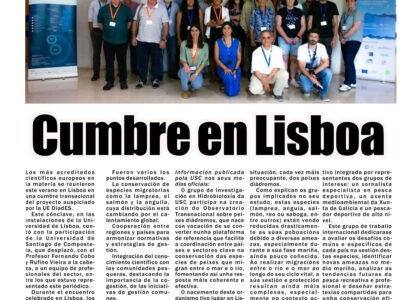
News on the Spanish newspaper “Trueiro” about the Transnational Observatory launch
The Spanish newspaper Trueiro, specialised in sport fishing, published a news piece about the launch meeting of DiadSea’s Transnational Observatory…
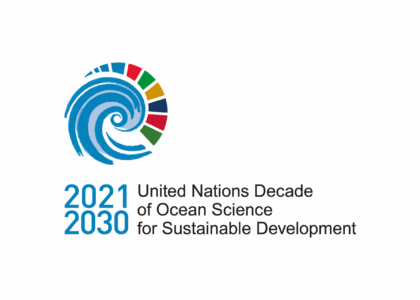
DiadSea is endorsed as a UN Ocean Decade Action
The DiadSea project, a transnational initiative focused on the conservation and management of diadromous migratory fish, has been officially endorsed…
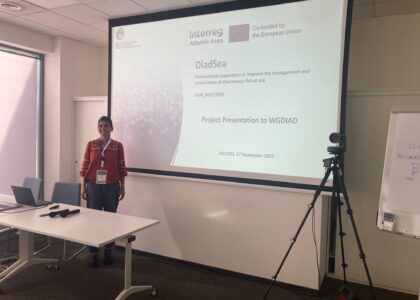
DiadSea at ICES Annual Science Conference 2025
Joana Boavida-Portugal from MARE – Marine and Environmental Sciences Centre (Universidade de Évora) presented the #DiadSea project at the ICES…


